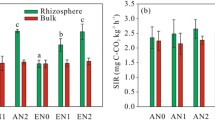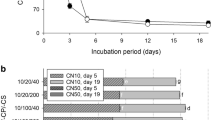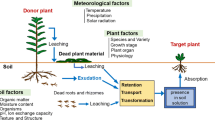Abstract
Studies of allelopathy have emphasized primarily the identification and quantification of phytotoxins in soils, with only limited attention directed toward how organic (carbon) and inorganic constituents (nutrients) in the soil may modify the action of such phytotoxins. In the present study, increasing carbon (C) levels (up to 108μg C/g soil) supplied as glucose, phenylalanine, orp-hydroxybenzoic acid did not alter morning-glory biomass, but similar C levels supplied as leucine, methionine, orp-coumaric acid were inversely related to morning-glory biomass. Similar joint action and multiplicative analyses were used to describe morning-glory biomass response to various C sources and to generate dose isolines for combinations ofp-coumaric acid and methionine at two NO3-N levels and for combinations ofp-coumaric acid and glucose at one NO3-N level. Methionine, glucose, and NO3-N treatments influenced the inhibitory action ofp-coumaric acid on biomass production of morning-glory seedlings. For example, results from the multiplicative analysis indicated that a 10% inhibition of morning-glory biomass required 7.5μgp-coumaric acid/g soil, while the presence of 3.68μg methionine/g soil thep-coumaric acid concentration required for 10% inhibition was only 3.75μg/ g soil. Similar response trends were obtained forp-coumaric acid and glucose. The higher NO3-N (14 vs. 3.5μg/g) treatments lowered the methionine and increased thep-coumaric acid concentrations required for 10% inhibition of morning-glory biomass. These results suggested that allelopathic interactions in soil environments can be a function of interacting neutral substances (e.g., glucose), promoters (e.g., NO3-N), and/or inhibitors (e.g., methionine andp-coumaric acid) of plant growth.
Similar content being viewed by others
References
Blum, U., andDalton, B.R. 1985. Effects of ferulic acid, an allelopathic compound, on leaf expansion of cucumber seedlings grown in nutrient culture.J. Chem. Ecol. 11:279–301.
Blum, U., Dalton, B.R., andShann, J.R. 1985. Effects of various mixtures of ferulic acid and some of its microbial metabolic products on cucumber leaf expansion and dry matter in nutrient culture.J. Chem. Ecol. 11:619–641.
Blum, U., Weed, S.B., andDalton, B.R. 1987. Influence of various soil factors on the effects of ferulic acid on leaf expansion of cucumber seedlings.Plant Soil 98:111–130.
Blum, U., Gerig, T.M., andWeed, S.B. 1989. Effects of mixtures of phenolic acids on leaf area expansion of cucumber seedlings grown in different pH Portsmouth A, soil material.J. Chem. Ecol. 15:2413–2423.
Blum, U., Gerig, T.M., Worsham, A.D., Holappa, L.D., andKing, L.D. 1992. Allelopathic activity in wheat-conventional and wheat-no-till soils: Development of soil extract bioassays.J. Chem. Ecol. 18:2191–2221.
Booker, F.L., Blum, U., andFiscus, E.L. 1992. Short-term effects of ferulic acid on ion uptake and water relations in cucumber seedlings.J. Exp. Bot. 43:649–655.
Broadbent, F.E., andTyler, K.B. 1962. Laboratory and greenhouse investigations of nitrogen mobilization.Soil Sci. Soc. Proc. 27:459–462.
Einhellig, F.A. 1987. Interactions among allelochemicals and other stress factors of the plant environment, pp. 343–357,in G.R. Waller (ed.). Allelochemicals: Role in Agriculture and Forestry. ACS Symposium Series 330. American Chemical Society, Washington, D.C.
Gerig, T.M., andBlum, U. 1991. Effects of mixtures of four phenolic acids on leaf area expansion of cucumber seedlings grown in Portsmouth B1 soil materials.J. Chem. Ecol. 17:29–40.
Gerig, T.M., andBlum, U. 1993. Modification of an inhibition curve to account for the effects of a second compound.J. Chem. Ecol. 19:2783–2790.
Gerig, T.M., Blum, U., andMeier, K. 1989. Statistical analysis of the joint inhibitory action of similar compounds.J. Chem. Ecol. 15:2403–2412.
Glass, A.D.M., andDunlop, J. 1974. Influence of phenolic acids on ion uptake.Plant Physiol. 54:855–858.
Hall, A.B., Blum, U., andFites, R.C. 1983. Stress modification ofHelianthus annus L. debris on seedling biomass ofAmamnthus retroflexusL.J. Chem. Ecol. 9:1213–1222.
Harmsen, G.W., andVan Schreven, D.A. 1955. Mineralization of organic nitrogen in soil.Adv. Agron. 7:299–395.
Hoagland, D.R., andArnon, D.J. 1950. The water-culture method of growing plants without soil. California Agriculture Experiment Station Circular 347.
Holappa, L.D., andBlum, U. 1991. Effects of exogenously applied ferulic acid, a potential allelopathic compound, on leaf growth, water utilization, and endogenous abscisic acid levels of tomato, cucumber, and bean.J. Chem. Ecol. 17:865–886.
Iritani, W.M., andArnold, C.Y. 1960. Nitrogen release of vegetable crop residues during incubation as related to their chemical composition.Soil Sci. 89:74–82.
Klein, K., andBlum, U. 1990. Effects of soil nitrogen level on ferulic acid inhibition of cucumber leaf expansion.J. Chem. Ecol. 16:1371–1383.
Lyu, S.-W., Blum, U., Gerig, T.M., andO'Brien, T.E. 1990. Effects of mixtures of phenolic acids on phosphorus uptake by cucumber seedlings.J. Chem. Ecol. 16:2559–2567.
McClure, P.R., Gross, H.D., andJackson, W.A. 1978. Phosphate absorption by soybean varieties: The influence of ferulic acid.Can. J. Bot. 56:764–767.
Rasmussen, J.A., andEinhellig, F.A. 1977. Synergistic inhibitory effects ofp-coumaric and ferulic acid on germination and growth of sorghum.J. Chem. Ecol. 3:197–205.
Rice, E.L. 1984. Allelopathy, 2nd ed. Academic Press, Orlando, Florida.
SAS Institute Inc. 1988. SAS/STAT User's Guide Release 6.03 Edition. SAS Institute Inc., Cary, North Carolina.
Stowe, L.G., andOsborn, A. 1980. The influence of nitrogen and phosphorus levels on the phytotoxicity of phenolic compounds.Can. J. Bot. 58:1149–1153.
Williams, R.D., andHoagland, R.E. 1982. The effects of naturally occurring phenolic compounds on seed germination.Weed Sci. 30:206–212.
Author information
Authors and Affiliations
Additional information
The use of trade names in this publication does not imply endorsement by the North Carolina Agricultural Research Service of products named, nor criticism of similar ones not mentioned.
Rights and permissions
About this article
Cite this article
Blum, U., Gerig, T.M., Worsham, A.D. et al. Modification of allelopathic effects ofp-coumaric acid on morning-glory seedling biomass by glucose, methionine, and nitrate. J Chem Ecol 19, 2791–2811 (1993). https://doi.org/10.1007/BF00980584
Received:
Accepted:
Issue Date:
DOI: https://doi.org/10.1007/BF00980584




